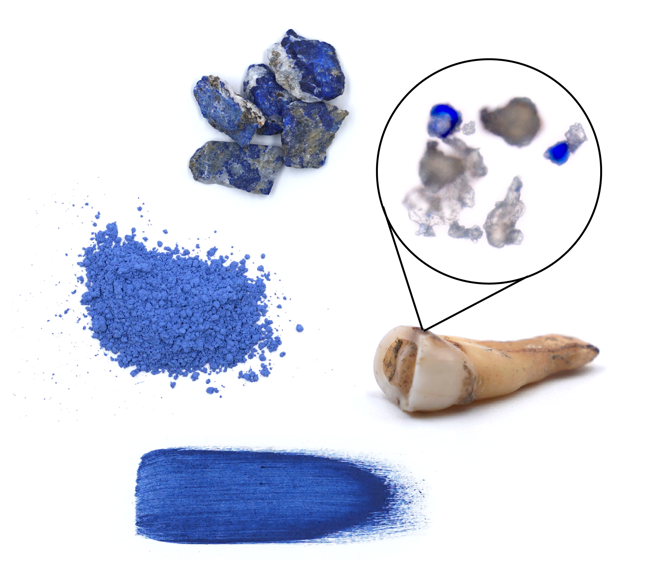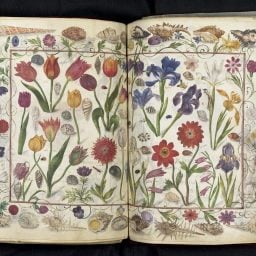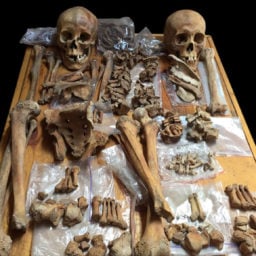Medievalists may have to reconsider long-held assumptions about who, exactly, painted all those gorgeous illuminated manuscripts. The intricate role of the scribe has been popularly attributed to medieval monks, but many of those artists may have actually been nuns.
When examining a woman’s skeleton from a monastery complex at Dalheim, Germany, Anita Radini of the archaeology department at the University of York was shocked to discover blue dental tartar. Testing eventually revealed that it was lapis lazuli, and the most likely cause is that the woman worked as an artist, licking her paint brush, or inhaling dust while grinding the expensive ultramarine stone used to make the rare pigment.
“This woman represents the earliest direct evidence of ultramarine pigment usage by a religious woman in Germany,” wrote Radini and her co-authors in a paper published in the journal Science Advances. The remains of the woman, who would have been between 45 and 60, were radiocarbon-dated to the 10th and 11th centuries.

Traces of lapis lazuli were found in the dental tartar of a woman who lived at a 12-century German monastery, leading researchers to believe she was a highly skilled artist who worked on illuminated manuscripts. Courtesy of Science Advances.
Other ruled out theories include pigment transfer from the kissing of illuminated manuscripts, but the practice was not common until some three hundred years after the woman would have died. And although there are Greek and Islamic manuscripts that prescribe lapis lazuli as medicine, it was not a treatment in Germany at that time, and the fineness of the powder suggests it was ground specifically for pigment.
Radini had been studying the teeth in an effort to see what tartar samples could reveal about monastic medieval diets, while her co-author Christina Warinner, a microbiome researcher at the Germany’s Max Planck Institute, was investigating the DNA of ancient oral bacteria. The blue tartar, obviously, sent them down a totally different avenue.
“Can you imagine the kind of cold calls we had to make in the beginning?” Warinner askeld the Atlantic. “‘Hi, I’m working with this thing on teeth, and it’s about 1,000 years old, and it has blue stuff in it. Can you help me?’ People thought we were crazy. We tried reaching out to physicists, and they were like, ‘I don’t know what you’re talking about.’ We tried reaching out to people working in art restoration, and they were like, ‘Why are you working with plaque?’”
Luckily, they found Alison Beach, a historian at Ohio State University who specializes in 12th-century female scribes in Germany, who immediately recognized the significance of the presence of the lapis lazuli.

Traces of lapis lazuli were found in the dental tartar of a woman who lived at a 12-century German monastery, leading researchers to believe she was a highly skilled artist who worked on illuminated manuscripts. Courtesy of Science Advances.
“Only scribes and painters of exceptional skill would have been entrusted with its use,” Beach said in a statement quoted by CNN.
The discovery means that women religious artists may have been more common than previously thought. Unfortunately, the monastery where the teeth were found was destroyed by fire in the 14th century, leaving no further evidence of the lives of the nuns who lived there, or their artistic activities.
“Identifying the early contributions of religious women to medieval book production is challenging due to the limited number of surviving books, the precarious documentation of women’s monasteries, and the tendency of scribes to leave their work unsigned,” explains the paper.
But the discovery of lapis lazuli in a woman’s teeth means that dental remains could be a new place to start looking for clues about women artists. It has also opened up a new area of research, with Warinner studying other tartar samples to see what she can learn about a person’s diet or occupation from what’s embedded in the buildup. So far, she has found traces of varied materials, such as wool fibers, insects, opium, and flower pollen.
As for our female scribe’s teeth, the find also indicates that the rare ultramarine pigment, previously thought to be available in limited capacities in medieval Europe, actually spread farther and more quickly than previously believed. Lapis lazuli typically comes from Afghanistan, and would have come to Europe via the Silk Road, a journey of some 4,000 miles.











